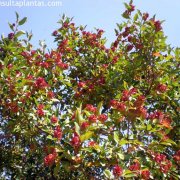Care of the tree Combretum kraussii or Forest bushwillow |
|
The genus Combretum, family Combretaceae, comprises 370 species of trees and shrubs native to South Africa, Madagascar and tropical regions of Africa, America and Asia. Some species are: Combretum kraussii, Combretum bracteosum, Combretum caffrum, Combretum micranthum, Combretum beardless, Combretum padoides, Combretum edwardsii. Common name: Forest bushwillow. This species is native to the eastern regions of South Africa. They are medium trees (10 meters/32.8 feet tall) with a rounded crown. They are interesting for the bright green leaves that turn red and purple in fall and winter. The flowers arise in axillary spikes and are small and cream-colored. The fruits have reddish wings that are very decorative. They are fast-growing plants used as shade trees, in public parks, and in pots for patios and terraces. They are highly recommended for shady areas of the garden. Combretum kraussii can grow in full sun, semi-shade or shaded exposure. It resists light frosts; in winter it's better that the temperature does not drop below 5 ºC (41 ºF). The soil must contain abundant organic matter and be well drained; it can be a garden substrate with compost and siliceous sand. Transplant in spring when the roots peek out from under the pot. Forest bushwillow can withstand several days of drought. Water moderately waiting for the substrate to be dry. Fertilize with compost or manure in the fall and with mineral fertilizer every 20 days during the spring and summer. Combretum kraussii tolerates the formation pruning done after flowering or at the end of winter very well. Forest bushwillow can be attacked by aphids or by mites; it's a plant quite resistant to pests. Combretum kraussii propagates by seeds sown in spring in a well-drained substrate and soaked one hour before sowing; they take between 15 days and a month to germinate. |
Images of the tree Combretum kraussii or Forest bushwillow |
Find plants
Combretum kraussii or Forest bushwillow | Care and Growing
© 2025 FavThemes


